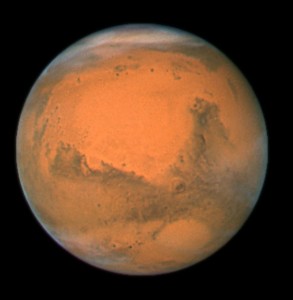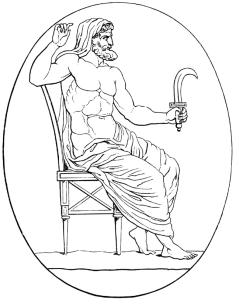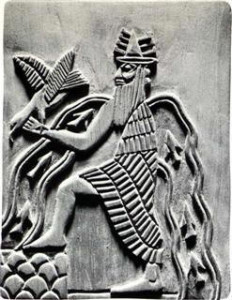by Erik M Roth, Shamanic Astrologer
 As we near the Summer Solstice, Saturn has come into prominence in the evening sky, rising into visibility in the eastern horizon as the sun sets in the west. The Sun is closing in on Mars, hiding the red planet in the star’s glow. About two weeks ago, both Mars and Saturn sat at opposite ends as we see them from the Earth (called an opposition in astrology), one orbiting “behind” the Sun and other nearing its annual closest point to Earth and also at its brightest. But both Mars and Saturn are always eclipsed in favorable attention (in astrology) by people toward Venus and Jupiter.
As we near the Summer Solstice, Saturn has come into prominence in the evening sky, rising into visibility in the eastern horizon as the sun sets in the west. The Sun is closing in on Mars, hiding the red planet in the star’s glow. About two weeks ago, both Mars and Saturn sat at opposite ends as we see them from the Earth (called an opposition in astrology), one orbiting “behind” the Sun and other nearing its annual closest point to Earth and also at its brightest. But both Mars and Saturn are always eclipsed in favorable attention (in astrology) by people toward Venus and Jupiter.
Venus and Jupiter are even brighter in night sky (except on very rare occasions when Mars is at its closest point to Earth does it become brighter than Jupiter). Venus, of course, is the 3rd brightest celestial body in the sky (after the Sun and Moon) and certainly garners a lot of attention by that simple fact. Traditional astrology has looked at Venus as a symbol of love, beauty, giving and receiving affections, romantic energy & associated relationships, benevolence and as a passive force or a stereo-typical ideal of the “female” in western culture. Jupiter has primarily been traditionally looked at as a force of expansion, optimism, amplification, benevolent and spiritual connection.
However, both Mars and Saturn are seen as malevolent forces in traditional astrology. Mars has been looked at as a symbol of action, aggression, rage, strength, recklessness, and the warrior archetype, but also will, desire and passions and the stereo-typical ideal of the “male” in western culture. Saturn, as a balancing force for Jupiter, represents in traditional astrology, contraction, limitation, fear, responsibility, patriarchy, the superego, father, accountability, time and old age, mortality, restrictions, hardship and an absolute absence of humor. Both Mars and Saturn have strong associations with modern-day issues with wars, artificial economic gyrations, dysfunctional governments and Big Brother with most of it centered around the ruling patriarchy. This can make these planets unfavorable in astrology (not to be confused with excitement that Saturn or Mars generates in astronomy, exploration and science fiction).
Traditional Western Astrology has painted a negative picture for the astrological planetary energies of both Mars and Saturn for several centuries. In this time of the Turning of the Ages, most, if not all perceptions and understandings of what we were taught decades and hundreds of years ago are being upset and overturned by new philosophies and understandings of nature and who and what we are on this globe and universe. That includes the astrological and cosmological understandings of Mars and Saturn.
Even with a revolution going on in the fields of astrology, cosmology and archeo-astronomy, Mars and Saturn are still getting a bad rap. Prior to the mid to late 20th Century, most astrologers have talked about Mars or Saturn with a certain judgment, projecting fear, heartbreak, loss, death and almost everything to avoid but locking a person (when giving readings) into a mindset that these planetary energies were working against the desire of the person to live their life. A few of those who would receive readings would inevitably want to learn more about the art of astrology and perpetuate what they learned, especially since the mediaeval period in Europe.
This is not to say that all of those astrologers were wrong, but merely tapping into the shadow elements of those planets (or shadows of zodiacal signs associated with those planets like Aries is with Mars) rather than looking at them holistically. In the revolutions of today, the word, holistic, has come to be associated with health, but it has come into form in many walks of life including astrology.
Mars in Astrology Today
While there are still some astrologers today carrying the old Mars forward, many others are using a measure of balance to their interpretations of Mars. Dana Gerhardt, in an article called “The Planets: Mars”, which is featured on arguably the most well-known astrology website, astro.com. This article describes some surface level expressions of Mars which can be inspiring, charismatic and fun, which gives Mars another light to be observed. However, Gerhardt shares her core understandings of Mars as “not delicate”, “likes action”, “Fiery and impulsive” and that “Mars craves a mission”. These are all true, but only in a few archetypal versions of Mars as expressed in human beings, from my own observations and studies through Shamanic Astrology.
Gerhardt’s interpretation brings Mars a little bit closer to a holistic viewpoint, but still a ways to go before it could be called that. Another astrologer, Clare Martin, who wrote “Mapping the Psyche”, goes into even less balance or holistic views of Mars when she describes Mars as “fundamentally competitive”, and “. . . a very physical planet, ruling adrenalin, the iron in the blood, the muscles, the genitals and the body’s excretory system.” And finally Mars is also described Mars as, “always been associated with passion and anger.” Martin does invite other ways to see Mars in its association with the “passive water sign of Scorpio,” and being “more subtle and controlled.” I mention these 2 astrologers because their articles are read by many on the popular astro.com website and further project the image of Mars as primarily an Aries-like warrior archetype.
Emily Trinkaus, a practicing astrologer, astrology teacher and author, on the other hand, acknowledges the light and shadow of Mars, and talks in detail about the 12 expressions of Mars (each of the 12 signs) and that Mars’ birth sign can show “how to activate your creative passion, inspire motivation, and break through creative blocks. It also reveals what you may have to fight for, or against, in order to express yourself.” (Creating with the Cosmos, pg 72 Trinkaus, Emily) This goes much further into a more holistic viewpoint of Mars, thereby assisting us out of the old judgment that Mars is malevolent in its nature.
While Mars will always have some association with the sign of Aries, in Shamanic Astrology, a holistic viewpoint is taken on Mars describing the red planet as “what version of the masculine principle he is working on the current life” for a man and “similar to the Jung’s animus, Mars is associated with the magical masculine.” (Shamanic Astrology Handbook 2012/2014 editions pg 96 Giamario, Daniel)
But what is the “masculine principle” or “magical masculine”. They are archetypally dependent upon a person’s Mars Sign. In essence, there are 12 different authentic major versions of the masculine and many shades in between. Daniel Giamario, the originator of the Shamanic Astrology paradigm explains in his article, “The Full-Spectrum New Mars Cycle 2014-2016” here:
“The Shamanic Astrology Mystery School continually questions and exposes the cultural and historical biases and assumptions regarding gender. We are quick to admit that human beings are pretty confused these days about masculinity and femininity and it seems that, culturally, we have far more clarity about what they are not. This is a subject that I am exploring in greater depth in a new book. However, the 12 signs, or archetypes of Mars, contain extremely useful and quite specific instructions for exploring our intended purpose as men and women at this time in history.”
With this more holistic look, Daniel describes how both men and women are not bound by one specific stereo-type of the male and female, but are graced with a plethora of authentic qualities, attributes and orientations that is in harmony with who people really are. The archetypes of the Healer, Individualist, Trickster, Nurturer, Shaman, Priestess/Priest, Teacher, Warrior, etc., are valid in all genders.
Saturn in Astrology Today
What about Saturn? A book that is commonly referred to those wanting to learn astrology and get fundamental details on Saturn in traditional western astrology is by Liz Greene, “Saturn, a New Look at an Old Devil,” This book does take steps in re-framing Saturn’s image and projection by many hundreds of years of prejudice. Greene’s introduction into the basic nature of Saturn concludes with an understanding of alchemy. She writes, “ . . . for the base material of alchemy, in which lay the possibility of gold, was called Saturn, and this base material, as well as having a concrete existence, was also considered to be the alchemist himself.” (pg 14 Saturn, a New Look at an Old Devil, Greene).
While Greene eludes to challenges in making friends with Saturn (or by many other names throughout recorded human history), her analysis points to Saturn as a necessary experience for people to truly grow and understand their nature at a deeper level. Greene builds a bridge away from the old paradigm of seeing Saturn as simply a malevolent planet, astrologically-speaking.
Returning to the popular astro.com, Clare Martin’s take on Saturn is closer to the traditional western astrology definition of Saturn, which is a bit darker and more judgmental in her interpretation than Greene’s book. However, Martin does show a sense of how to obtain wisdom and self-sufficiency through Saturn, but it is crowded in with statements like, “as we sow, so shall we reap” and “cutting the thread of life with his sickle when the appointed time comes.” (http://www.astro.com/mtp/mtp42_e.htm an excerpt from her book, “Mapping the Psyche” Martin, Clare)
Breaking from traditional western astrology, Shamanic Astrology shows another view. Good or Bad does not apply in the language of Shamanic Astrology as every planet has its light and shadow. Giamario writes in the Shamanic Astrology Handbook “The essence of Saturn is connected to man-made law or humanity’s law”. Furthering that interpretation, he describes, “Saturn represents the operating manual, or the law, (but) it doesn’t say specifically what the content of the law has to be. That can, and has changed collectively throughout history.” (Shamanic Astrology Handbook 2014 edition pg 99 Giamario, Daniel)
So, the responsibilities and trials we experience through Saturn depend on the culture and time in which we are living. This view frees humans to exercise their free will to honor the essence of Saturn in helping evolve the culture’s or our personal operating manual (or re-writing it completely) to something more harmonious and aligned with our soul’s intent.
A Glance at the Lineage of Mars and Saturn
The essences the archetypal energy of both Mars and Saturn, like the other planets named after the Roman Gods and Goddesses, go back many thousands of years, at least to ancient Sumer and Egypt and likely well-before those cultures rose to prominence 5000+ years ago. The rise of the patriarchal-based cultures and monotheistic religions in the last 2,500-3,000 years has transformed the ancient gods and goddesses and thereby the mythic imprints in all of us into (when they are not provided for) “diseases” (Re-Visioning Psychology pg 14, Hillman, James). James Hillman’s school of thought came from Jungian psychology and it is well-known Jung wrote about the gods and goddesses being transformed into not just diseases, but also psychological complexes, neuroses and buried patterns when we ignore or repress those archetypal-forms.
In the Jungian school of thought, there is a general call to bring these complexes and neuroses to the consciousness in order to work with them and see the underlying issues. The shadow, which appears through the psychological or planetary complexes typically guide us in the unconscious realm, reminding us of our soul’s journey. These buried patterns were shoveled over through the powerful forces of monotheistic religions and patriarchal culture and governments. The gods and goddess were placed in the categories are falsehoods, devils, demons and the intimate connection to the primal world.
If one goes back far enough to where Mars and Saturn originated, one will find a different understanding of those god-forms. For Saturn, there are two known precursors (there are others that are less well-known) that are present long before the Roman Empire or Classic Greece (Saturn was known as Kronos/Cronos/Chronos, depending on the time frame and interpretation). Saturn/Kronos was typically pictured with the sickle and symbol of the deity’s connection to the land and harvest. Saturn’s connection to the Earth runs deep. In ancient Sumer, Saturn was known as Enki or Ea and was one of the core deities. Enki was known to walk the Earth with the people and was responsible for the people and tended to side with them whenever disputes arose amongst the gods/goddesses.
Enki also was the one in Sumerian/Babylonian myth to explain to the Noah-figure, Utnapishtim, to build a boat and save humanity from a flood that Enki was unable to prevent. This action alone shows Enki’s nature and how much it was transformed in ancient Greece and Rome and even more so in last 2,000 years. In ancient Egypt, Saturn had a connection to the god Ptah, who was the teacher of the “architect of the cosmos”, Imhotep, was is credited with designing and building the first step pyramid in Saqqara of Egypt during the Early Dynastic Period (see the book Imhotep the African by Robert Bauval and Thomas Brophy for further information on Imhotep).
Saturn also was commonly known to the ancients to be the ruler of humanity’s Golden Age, a time when people were lived in harmony with nature. In the landmark book, Hamlet’s Mill, it is written, “It is the Golden Age, in Latin tradition, Saturnia regna, the reign of Saturn; in Greek, Kronos.” (pg 146, by Giorgio de Santillana and Hertha von Dechend)
The other planet of “traditional” interpretation as an aggressive, lustful and warrior-like qualities is Mars. Prior to the Romans, he was known as Ares (not to be confused with the modern zodiacal sign of Aries, though there is a connection) in ancient Greece. But who was he before that? On the island of Crete, Mars was known as Enyalios during the Mycenaean culture and prior to that Mars was noted as Nergal during the Akkadian and Babylonian period in ancient Mesopotamia and could go farther back than 2000 BC. In ancient Sumer, there are other figures, Tammuz and Dumuzi, which have great connections to the pre-cursor of Venus, Inanna/Ishtar.
The Hymn to Ares by Homer (excerpt)*
” . . . so that I can shake off cruel cowardice from my head, and diminish that deceptive rush
of my spirit, and restrain that shrill voice in my heart that provokes me to enter the chilling din of battle . . .”
The qualities that described for Nergal, Tammuz and Dumuzi differ to some extent but they bear only a few in common with the Roman Mars. This god-form(s) have major parts to play in the stories of the underworld, aspects of the hero, Heracles and god Ares in Ancient Greece. According the entry for Nergal in Wikipedia, he had some association with Satan or a demon and was part of Hell. However, Tammuz/Dumuzi has a major connection to the land, the solar season when it was warmer and the courtship with Inanna (aka Venus). While this requires much more research, there appears to be a split at some point where Nergal was cut off from Tammuz/Dumuzi over a period of hundreds of years, spreading over the Mesopotamia and Northern Africa (in Phoenician culture). While there is some allusion to battle with those gods, it was transformed into a “war-machine” around the time of the advent of Roman Republic/Empire.
Final Thoughts on Mars and Saturn
In the last year or so, I’ve become more and more curious as to why when Saturn or Mars is talked about, there is a general reaction as if something bad, negative or depressing is coming and to exercise great caution when it arrives. Sometimes, these reactions come from a person receiving a reading or talking to another astrologer. Or the other may speak about those planets as a necessary evil. They are not popular topics in astrology when compared to Venus or Jupiter. But I’ve found they are extremely integral to the makeup of our Self and Soul.
Saturn produces necessary conditions for us to commit to our life’s journey in a constructive fashion and that we are accountable to the care of our soul’s intent. It is about growth through limits and barriers and a focused direction. For Mars, it is breaking of chains from the one or two-dimensional versions of men and also that all of have an inner masculine energy or animus within.
We as a civilization and a people can look at the past as a way to create healing for the present and the future. We are co-creators of are own paradigm and we can choose what our reality is to some extent. Who are we as men inside and expressed outside? Who are we as women inside and outside ourselves? What does our soul want? There are questions we can ask ourselves on a deep level in order to connect to being authentic human beings.
A good exercise is to look up at the night sky for those two planets during the year and be open to what you experience as the planets transit astrological signs, constellations and connect with stars and other planets. Meditate on the visual and psychic connection with the planetary energies, including the complexes and shadow and bring them into life. Be an active participant in your own initiations on the journey of wholeness to discover what Saturn and Mars means for you.
*A Terrible Love of War by James Hillman pg 203
References
BOOKS
- The Archetypal Cosmos by Keiron le Grice
- Creating with the Cosmos by Emily Trinkaus
- Finding Meaning in the Second Half of Life by James Hollis
- A Handbook for the Humanistic Astrologer (2000 Edition) by Michael R Meyer
- Imhotep the African by Robert Bauval and Thomas Brophy PhD
- Myths of Mesopotamia, translation by Stephanie Dalley
- Re-Visioning Psychology by James Hillman
- Saturn, a New Look at an Old Devil (2011 Edition) by Liz Greene
- Shamanic Astrology Handbook, 2012/2014 Editions by Daniel Giamario with Cayelin Castell
- Hamlet’s Mill by Giorgio de Santillana & Hertha von Dechend
WEBSITES/ARTICLES
- Wikipedia – Tammuz http://en.wikipedia.org/wiki/Tammuz_(deity)
- Wikipedia – Nergal http://en.wikipedia.org/wiki/Nergal
- The Planets: Mars by Dana Gerhardt http://www.astro.com/astrology/in_dg_mars_e.htm
- Mapping the Psyche by Clare Martin (Mars) http://www.astro.com/mtp/mtp32_e.htm
- Mapping the Psyche by Clare Martin (Saturn) http://www.astro.com/mtp/mtp42_e.htm
- The Full-Spectrum Mars Cycle 2014-2016 by Daniel Giamario http://shamanicastrology.com/archives/3340


